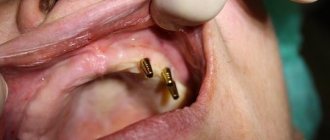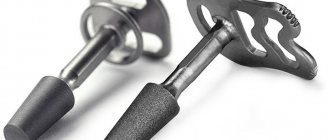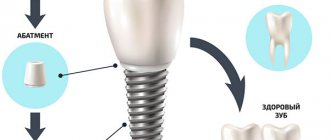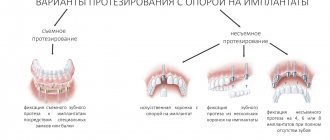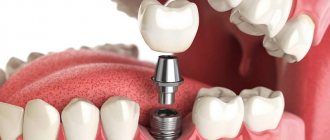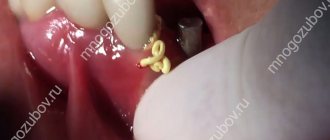A basal implant (root-shaped) is narrower in shape than a classic implant. It is installed in the deep layer of bone tissue (basal layer). Does not require an incision in the gums before installation. A small puncture is made in the gum, through which the implant is inserted into the bone (implantation without incisions!).
The method has gained great popularity in the countries of Eastern and Western Europe, Israel, and the CIS countries. Belarus is one of the leaders in the CIS countries in installing basal implants.
Why is basal implantation so popular today?
Not all clients are suitable for classical dental implantation due to the banal lack of bone tissue in order to fully implement it. Doctors have to resort to sinus lifting - artificial tissue expansion. However, this process increases not only the time spent on the procedure, but also the cost of the service.
Dental implantation, in addition, can be recommended to almost all people who need it, even those for whom conventional methods are simply not suitable physiologically. Just a few years ago, such patients had no chance. Today, thanks to advances in the medical field, they too will be “saved.” In general, implantation can be avoided if pulpitis and similar diseases are treated in time.
Alternative methods of dental implantation
Basal Complex is performed in complex clinical cases when the classical method is not possible due to thinning of the bone tissue. The center offers patients similar systems with single-phase loading from proven brands. For prosthetics on implants use:
- Nobel BioCare All-on-4/6;
- ]Straumann Pro-Arch[/anchor] systems;
- MegaGen with unified protocols;
- classic method with tissue extension.
There are not many specialists of this level in Belarus. Our surgeons and orthopedists have undergone foreign practice and have the appropriate licenses. You can read about the work of specialists in the reviews section.
The article was prepared by a specialist:
Current limitations of basal implants
Still, basal implantation has some limitations. If you decide to resort to it, then first familiarize yourself with them. Although, of course, the clinic doctor will tell you about them at your appointment:
- It is impossible to place only one basal implant; at least three are needed. The load on such implants must be distributed evenly, otherwise it will be an inferior replacement for a real tooth and will not be able to fully perform all its functions.
- The period of time that must pass between the moment of installation of the “root” of the implant and its “top” is at least one year. This is exactly how much it will take for everything to take root. And for now you will have to go with a metal frame and a metal-plastic crown. It will be possible to install metal ceramics only after twelve months.
It should also be said that such an operation should only be carried out by a specialist of the highest class; this procedure requires true skill.
And finally, only a good doctor can determine whether this dental implant technology is suitable for a patient. He will be able to understand this from a panoramic photograph of the patient’s jaw.
Today the Republic of Belarus is a leader in the number of dental implants. And our DEC dental clinic is rightfully considered one of the leaders in the field of basal dental implantations in Minsk. Our specialists visit the largest medical centers in Switzerland, Germany and Israel to improve their skills.
Diagnostics and preparation at the Family Dentist clinic
During the consultation, the desired result of prosthetics is discussed and a dental rehabilitation plan is drawn up. First comes the orthopedic planning, then the surgeon selects the model and size of the implants. Our orthopedic dentist collaborates with the implantologist to determine whether the prosthesis will be aesthetic and functional. One-stage implantation is a team effort; it is necessary to undergo examination and treatment:
- 3D tomography is prescribed to determine the angle and depth of the rod, the presence or absence of pulpitis and granuloma, and the volume of the jaw bone.
- Sanitation is carried out to ensure the greatest possible sterility. The dentist removes plaque, treats caries and complications. The periodontist, using the Vector device, removes tartar, treats gum pockets, and relieves gum inflammation.
- Instructions are provided on the care of dentures on implants.
Make an appointment in advance for a consultation with a Family Dentist to determine the feasibility of basal implantation and prepare for the procedure. Our dentistry employs doctors with 15–20 years of experience. You can count on the competence and friendliness of the staff.
Recommendations for our patients after installation of basal implants
After the basal implants have been installed, each doctor at the DEC dental clinic gives the following recommendations:
- It is necessary within the first ten days, no matter how uncomfortable it may be, to begin loading the installed implants by chewing food. Only then will they begin to take root.
- The implant will take four to six months to take root. During this time, it can “settle” by several millimeters. You should not pay attention to this, especially since this is why metal-plastic rather than metal-ceramic crowns are installed in the first year.
Advantages of All-on-4/6 prosthetics
Compared to basal implantation, the All-on-4/6 technique has a number of advantages, including: use in cases of significant bone atrophy in the lateral sections and in the presence of sinusitis (sinusitis). The use of All-on-4/6 does not require a sinus lift, which, accordingly, allows you to save a significant amount.
Also, the installation of implants with multi-units can be performed on patients with significant malocclusions. The technique does not fundamentally correct bite defects, but allows for maximum correction to achieve better aesthetics.
In the case of using the All-on-4 and All-on-6 techniques, all elements of the prosthesis are connected to the implants with screw fixation.
To summarize: why our clinic does basal implantation in Minsk
Today we can offer our patients this method of implantation, as one of the most effective in several respects:
- It is a one-stage procedure - the operation can be performed immediately after tooth extraction.
- Fast. At the DEC dental clinic, up to twenty implants can be placed in a week, if necessary. When using the classical method, this takes from four to six months.
- Cheap - to carry out a full cycle, fewer surgical interventions are required, and, accordingly, less work for the surgeon. And, as a result, all procedures cost less.
- With this method, the patient’s adaptation to normal life takes virtually no time. Once the implant is installed and the necessary post-procedures are carried out, the person can live as usual
- Suitable for almost everyone - even heavy smokers who are contraindicated for classical implantation.
As for calculating the specific cost of basal dental implantation in Minsk and the price of such an operation, everything is individual. A personal plan for completing all procedures is developed for each client, and depending on the required number of procedures, the total amount that the entire process will cost him is determined.
The entire implantation process is carried out according to protocols approved by the Ministry of Health of the Republic of Belarus.
Description of All-on-4/6 implantation
What is remarkable about this technique? The main distinguishing feature is that the installation of the two outer implants is carried out at angles, and the central ones - in a vertical position. In addition, the tops of the implants (abutments) also have angular positions and are called multi-units. The advantage of this design is to minimize the risks of inflammation and loosening during active chewing load.
All-on-4/6 is carried out without incisions in the gums: implants are installed through small punctures. Thus, the gums and bone are not injured, which prevents the development of large swelling in the postoperative period. Reducing the rehabilitation period contributes to a speedy recovery and return to normal life. In addition, All-on-4/6 implantation prevents bone loss due to immediate chewing load almost immediately after the installation of crowns.
When implanting All-on-6, a maximum functional bridge of 12-14 crowns is installed. In some cases, when the volume of bone tissue in the lateral regions is critically low, and also taking into account individual characteristics, we perform implantation on patients using the “all on four” technique. Then the prosthesis will have a shortened appearance of 10 crowns.
Implantation with six units is more reliable in the long term, so we use this technique in most cases.
Crown material for All-on-4/6 prosthetics
In the manufacture of prosthetics, we use innovative high-quality materials. Practical experience in using metal-acrylic crowns has shown that this is not the most reliable material. During use, such prostheses darken, wear out and break. There is a need to replace the prosthesis with a more durable material within a year after installation.
We abandoned the use of this material in favor of cold polymerized plastic Top.Lign Professional. The reliability and durability of this certified German material is due to the resistance of the plastic. Manufactured dentures have a more aesthetic appearance. Detailed comparative characteristics can be found in the table:
| Characteristics | Metal acrylic prosthesis | Prosthesis made of cold polymerized plastic Top.Lign Professional |
| Prosthesis weight | Big | Smaller |
| Presence of a metal base | Eat | Absent |
| Strength | Smaller; the material is more fragile and more often susceptible to mechanical damage | Large; the material is more flexible and durable |
| Timing of prosthetics | 7 calendar days | 1 calendar day! |
| Life time | 1-1.5 years | Up to 3 years |
What implants do we use?
To carry out All-on-4/6, DENTISTRY uses more than one implant system. This is due to the fact that there is no unified brand in the world that would cover solutions for all possible clinical cases. In general, certain implant systems are great for addressing issues in the anterior jaw, while others are great for addressing bone atrophy issues in the posterior jaw. Implants also differ in surface design, titanium purity and other characteristics.
Currently in our practice we use the following brands of implants: - Noris (Israel); — Megagen (Korea); — OSSTEM (Korea); — Straumann (Switzerland); — Nobel Biocare (Sweden).
Our distinctive characteristic is also that we use the concept of “implant friendship”, when it is possible to use implants of brand A and brand B together to solve the individual situation of the patient. Thus, we do not tailor the capabilities of any one implant system to the patient, but use the combination of the strengths of different brands to achieve maximum results.
Immediate implantation
Sometimes the dentist decides on immediate implantation. Although it is difficult to prepare an ideal prosthesis without clear data, in some cases it is necessary:
- inability to set a dislocated tooth
- Chronic periodontitis, extending to both the root and crown
- displacement of a tooth root due to a fracture
- first and second degree periodontitis
- chronic periodontitis that is not amenable to conservative treatment
This procedure is performed only after bone formation is complete.


